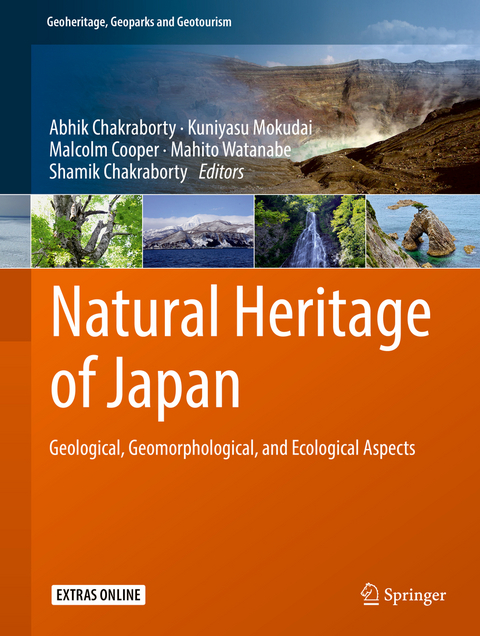
Natural Heritage of Japan
Springer International Publishing (Verlag)
978-3-319-61895-1 (ISBN)
Abhik Chakraborty is a Lecturer at Center for Tourism Research, Wakayama University. His research interests include complex environmental systems, landscape change, nature conservation and the Anthropocene. Kuniyasu Mokudai is currently the CEO of Japan Geoservice Inc, a consulting firm for the protection and interpretation of geological heritage. His field of specialization is mountain geomorphology and nature conservation science. Malcolm Cooper is Emeritus Professor at Ritsumeikan Asia Pacific University. He has held previous appointments at the Universities of New England, Adelaide and Southern Queensland (Australia), and Waiariki Institute of Technology (New Zealand). He has worked in the environmental planning and tourism policy areas for Federal, State and Local Governments in Australia, and as both a private environmental consultant and a tourism education consultant to the Governments of Sri Lanka, China and Vietnam. Mahito Watanabe is at the Geological Survey of Japan, AIST. His field of specialization is Geology, especially biostratigraphy of the Neogene sediments. He has been instrumental in introducing and disseminating the Geopark concept in Japan. He is also currently involved in evaluation of global geoparks as a Member of the UNESCO Geopark Council and networking of geoparks as Member of the Exective Committee of the Global Geoparks network and the Advisory Committee of the Asia Pacific Geopark Network. Shamik Chakraborty is a postdoctoral research fellow at the Institute for the Advanced Study of Sustainability, United Nations University (UNU-IAS), and a Visiting Research Fellow at the Integrated Research System for Sustainability Science (IR3S), The University of Tokyo. His research interests include socio-ecological systems, particularly, the study of human-environment interactions in coastal and river basin environments.
Introduction.- Geology of the Japanese Islands: An Outline.- Volcanic Archipelago: Volcanism as a Geoheritage Characteristic of Japan.- Shiretoko Peninsula: Dynamic Interaction between Geology, Geomorphology and Ecology at The Interface of Terrestrial and Marine Systems.- Shirakami Mountains: Old-growth Forests of Siebold's Beech Supporting Biodiversity in a Dynamic Landscape.- Ogasawara Islands World Heritage Area: An Outstanding Ecological Heritage.- Yakushima Island: Landscape History, World Heritage Designation and Conservation Status for Local Society.- The Origin and Development of Geoparks in Japan: Reflections from a Personal Perspective.- San'in-Kaigan UNESCO Global Geopark: Geology and Conservation of the Oriental Stork.- Muroto Geopark: Understanding the Moving Earth.- The Interface of Geology, Ecology and Society: The Case of Aso Volcanic Landscape.- The Mt. Unzen Disaster: A Terrible Learning Experience.- Challenges for Geoconservation in Contemporary Japan.- The Lake AkanArea: A Future Geopark.- Oze Wetland: The Birth Place of the Nature Conservation Movement in Japan.- Mount Fuji: The Volcano, the Heritage and the Mountain.- Synthesis.
| Erscheinungsdatum | 02.12.2017 |
|---|---|
| Reihe/Serie | Geoheritage, Geoparks and Geotourism |
| Zusatzinfo | XII, 183 p. 131 illus. |
| Verlagsort | Cham |
| Sprache | englisch |
| Maße | 210 x 279 mm |
| Gewicht | 673 g |
| Themenwelt | Naturwissenschaften ► Biologie ► Botanik |
| Naturwissenschaften ► Biologie ► Ökologie / Naturschutz | |
| Naturwissenschaften ► Geowissenschaften ► Geologie | |
| Schlagworte | Botany & plant sciences • Botany & plant sciences • conservation of the environment • Earth and Environmental Science • earth sciences • Geology • Geology, geomorphology & the lithosphere • Geology, geomorphology & the lithosphere • geomorphology • Geomorphology & geological surface processes • Geomorphology & geological surface processes • Geoparks of Japan • landscape ecology • nature conservation • Ramsar Sites • World Heritage |
| ISBN-10 | 3-319-61895-4 / 3319618954 |
| ISBN-13 | 978-3-319-61895-1 / 9783319618951 |
| Zustand | Neuware |
| Haben Sie eine Frage zum Produkt? |
aus dem Bereich


